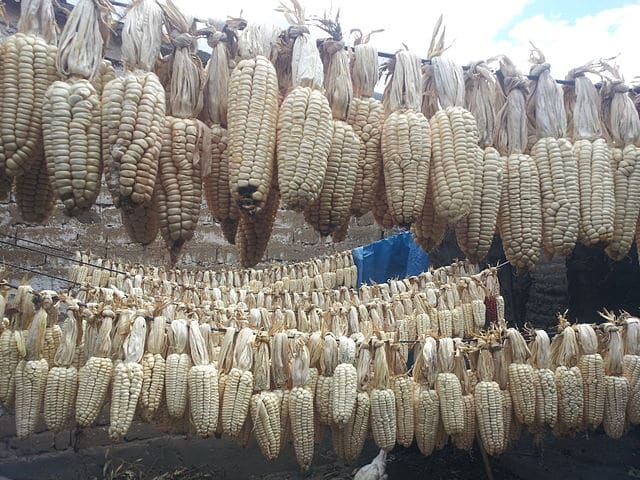Giant Corn:
What is it?, history, cultivation, nutritional value, uses, recipes, and more...
Corn is a highly energizing cereal rich in digestible nutrients. It provides proteins and minerals such as calcium, iron, and phosphorus, and serves as a significant source of carbohydrates, mainly polysaccharides.
It’s a starchy maize belonging to the Poaceae family, Zea mays species. In the Cusco Region, a representative variety of corn is known as “Blanco Urubamba” or “Giant White Corn of Cuzco.” Its ecological niche is within the Sacred Valley of the Incas. The name “maíz blanco” refers to the grain’s color, and it’s termed “gigante” due to the exceptional size of its kernels.
Índice
What is Giant White Corn of Cuzco?
The Giant White Corn of Cuzco, registered as Blanco Urubamba (PMV-560), is a representative variety of corn originating from the Cusco department, specifically from the Sacred Valley of the Incas. It grows at elevations between 2,600 and 3,050 meters above sea level, reaching heights of 2 to 3 meters. It stands out for its thick stem without tillers, light red in color, with 10 leaves, and it is a late-maturing plant, flowering at around 140 days.
Its cob is large, thick, and ellipsoidal, measuring about 18 cm in length and 7 cm in diameter on average, although sometimes it can reach up to 30 centimeters in length, with grains exceeding 2 centimeters in diameter.
It features 8 regular rows of large, smooth, white, circular, starchy grains with a thin texture. The husk can be white, red, cherry, or brown.
The name “maíz blanco” derives from the color of its grains, and the term “gigante” refers to the exceptional size of the kernels. “Cusco” references the geographical area of its origin.
History of Giant White Corn of Cuzco
Evidence of the Giant White Corn of Cuzco has been found in a carved wooden representation discovered in the Pachacámac sanctuary (400 to 900 A.D.), where the deity Pachacámac is depicted with corn cobs tied around the waist. The artwork displays 4 corn cobs, each with 4 rows (as the artwork only shows half of each cob, they are actually eight-row cobs, which corresponds to the characteristic feature of the paraqay sara or white corn).
In other pre-Columbian cultures, such as the Wari culture, evidence of the presence of this corn variety has been found in the form of ceramics and other artistic expressions.
Its appearance is believed to be relatively recent, occurring during the Inca period. It stands as one of the most valuable legacies of Inca culture to humanity, demonstrating their advanced agricultural practices. During this period, there was a complex experimentation center called Moray, where the techniques for crossbreeding were likely developed, resulting in the formation of the giant white corn.
According to the renowned scientist Paul Mangelsdorf, “Cusco giant white corn has reached the most advanced level of domestication, making it a variety with a superior chromoplast.” (The Origin of Corn, 1947)
Moreover, the chroniclers of that era frequently mentioned a mythical variety of corn with exceptionally large and white kernels, which undoubtedly corresponds to the giant white corn.
Since 1950, this corn began to be exported to international markets due to the exceptionally large size of its kernels and its tender composition, distinguishing and highlighting it. It is particularly appreciated in the production of snacks, which is its most common use nowadays. During these years, some associations of corn producers emerged within the Urubamba Valley: The Cooperative of the Sacred Valley of the Incas, ASAGROPEVASAIN, the Agricultural Association of the Sacred Valley of the Incas, VSISA, the Sacred Valley of the Incas Anonymous Society, was formed in 1977, followed by AGROTRADE Valle de los Incas, and subsequently APROMAIZ, the Association of Giant White Corn of Cuzco Producers.

Common Name of Giant White Corn
| Spanish | Maiz blanco gigante del Cuzco, Maíz Paraccai-Sara, Maíz Cuzco Gigante |
| Quechua | Paraqay Sara, Paracay Sara, Paraccai-Sara |
| English | Giant-seeded maize, Cuzco maize, Giant-seeded corn |
Scientific Name of Giant White Corn
Zea mays
Taxonomy of Giant White Corn
| Kingdom | Plantae |
| Subdivision | Magnoliophyta |
| Class | Liliopsida |
| Subclass | Commelinidae |
| Order | Poales |
| Family | Poaceae |
| Subfamily | Panicoideae |
| Tribu | Andropogoneae |
| Subtribu | Tripsacinae |
| Gender | Zea |
| Specie | Zea mays |
Synonymy of Giant White Corn
- Zea alba Miller
- Zea amylacea Sturtevant
- Zea amylesaccharata Sturtevant
- Zea cryptosperma Bonafous
- Zea curagua
- Zea erythrolepis
- Zea glumacea Larrañaga
- Zea indentata Sturtevant
- Zea indurata Sturtevant
- Zea japonica van Houtte
- Zea macrosperma Klotzsch
- Zea mucronata Vilmorin
- Zea rostrata Bonafous
- Zea saccharata Sturtevant
- Mays vulgaris Seringe
- Mays zea Gaert.
- Thalysia mays Kuntze
- Zea americana Mill.
- Zea segetalis Salisb.
- Zea tunicata (St-Hilaire) Sturtevant
- Zea vulgaris Miller.
Etymology of Giant White Corn
The term “Zea” comes from “zēa” (derived from the Greek ζειά, zeia) spelta, a plant similar to wheat mentioned by Pliny: the name used by Linnaeus for corn. The specific term “mays” derives from maize.
The word “maize” entered the Spanish language as a loanword from the Taíno word “mahís,” which literally means ‘that which sustains life’. In the Andes, it is also known as “sara,” a Quechua word.
After analyzing the Quechua name for this plant, “paraqay sara,” which translates to “corn” (“sara”) and “paraqay,” which describes its characteristics besides the white color (large, floury, soft-textured grain, flattened shape, nutritious food that satisfies hunger), the term “Giant” is added.
Cultivation, Distribution, and Habitat of Giant White Corn
- Habitat
The cultivation of Giant White Corn of Cuzco takes place in the Cusco department (Peru), between the provinces of Calca and Urubamba, from the district of San Salvador to the populated center of Chilca in the Ollantaytambo district, covering a stretch of approximately 70 km in length on both sides of the Vilcanota River in the area known as the Sacred Valley of the Incas. This corn grows at an altitude between 2,600 and 3,050 meters above sea level, where a temperate temperature favors the cultivation of this and other products. Temperatures around 25ºC are most suitable for its growth as they promote better starch synthesis, while nights with low temperatures that do not reach freezing are crucial for the hydrolysis of starch accumulated in the leaves into simple sugars and their movement to the stems and grains.
The lands in the area are fertile and mechanizable (flat or slightly undulating terrain, with no microrelief problems, suitable for machinery), and they have abundant water from the Vilcanota River basin. Its production process is usually carried out manually by farmers with limited use of technology. The cultivation area covers the provinces of Calca, districts of San Salvador, Písac, Taray, Coya, Lamay, and Calca, and the province of Urubamba, districts of Urubamba, Huayllabamba, Ollantaytambo, Yucay, and Maras.
Soil preparation for cultivation includes deep irrigation, plowing for oxygenation, and leveling the terrain. For planting, the furrows should maintain a distance of 0.80 meters.
An important limitation of this cultivation is the limited possibility of expanding it beyond the Sacred Valley, as it requires very specific climatic and geographical conditions to produce corn of the size and quality that international markets demand.
Geographical Distribution of Giant White Corn

Cuzco
Seasonal Availability of Giant White Corn
- April, May, June
Nutritional Value of Giant White Corn
Giant White Corn from Cusco is a highly energetic food abundant in digestible nutrients. It stands out for its levels of calcium, phosphorus, magnesium, and potassium. Additionally, it contains B-complex vitamins (B1, B2, and B5), as well as ascorbic acid.
It provides significant amounts of proteins and, due to its content of polyunsaturated fats, supports the cardiovascular system’s function.
In 100 grams of this raw and dried corn, there are 76.1 grams of carbohydrates, providing the necessary vigor for daily routines. Moreover, it is notable for its high starch content, which provides a satiating effect that helps reduce total intake without feeling hungry, along with a range of vitamins and minerals, including calcium, phosphorus, iron, and zinc.
Health Benefits of Giant White Corn
Giant white corn is a good source of proteins, vitamins, and minerals; it also produces a satisfying effect that’s ideal for weight loss regimens.
Contraindications or Side Effects
While there is currently no evidence that these foods pose a health risk, due to their high starch content, they could potentially trigger allergies with reddening or rashes.
| 10 Porciones por Kilogramo | |
| Tamaño de porción | 100g |
| Cantidad por porción Calorías |
343 |
| Cantidad por 100g | |
| Energía | 1,437 kJ |
| Grasa Total | 4.0 g |
| Sodio | ● |
| Carbohidratos totales | 76.1 g |
| Carbohidratos disponibles | 72.9 g |
| Fibra Dietaria | 3.2 g |
| Proteínas | 5.9 g |
| Calcio | 5 mg |
| Fósforo | 249 mg |
| Zinc | 1.91 mg |
| Hierro | 1.48 mg |
| Potasio | ● |
| Agua | 12.7 g |
| Cenizas | 1.3 g |
| Vitamina A | 1 μg |
| Tiamina (B1) | 0.25 mg |
| Riboflavina (B2) | 0.05 mg |
| Niacina (B3) | 2.26 mg |
| Vitamina C | 2.60 mg |
| Acido Fólico (B9) | ● |
| β-Caroteno | 0 μg |
| Fuente: Tablas peruanas de composición de alimentos – Centro Nacional de Alimentación y Nutrición – Ministerio de Salud – Perú | |
Derived Products and Consumption Forms of Giant White Corn
Uses of Giant White Corn
The main use of Giant White Corn is for direct human consumption in a variety of signature dishes. It’s also widely accepted as an export product in the form of whole kernels, flour, and snacks.
- Culinary
- Medicinal
- Industrial
- Ritual
Culinary Use of Giant White Corn
In Peru, Giant White Corn from Cusco is used in traditional dishes such as "lawa" (a soup made from fresh white corn, lima beans, dried yellow chili, and huacatay), "Chiri Uchu" (served with a tortilla made from white corn flour, egg, and scallion stalks). It's also used in making humitas (sweet white corn dough filled with cinnamon and raisins, wrapped in corn husks and steamed), tamales (white corn dough filled with meat, wrapped in corn husks and steamed). It's used to make maicena (corn kernels reduced to flour or de-greased, easily digestible, and very nutritious).
Another way to consume it is as "mote", a process in which the corn is boiled and the skin is removed using natural abrasives, traditionally transforming it into chicha, an alcoholic beverage obtained by fermenting corn with sugar or honey. Additionally, farmers often turn this corn into chochoca to extend its storage period and prevent infestations in storage. Chochoca is precooked, dehydrated, and ground corn used in soups.
Furthermore, its high-quality grains can be consumed as "choclo" (corn on the cob), mote, toasted, fried, creams, mazamorras, bread, snacks, among others.
Medicinal Use of Giant White Corn
Among the main medicinal properties of this plant are:
Its easy digestion, making it an ideal food for children and athletes. Recommended for people with magnesium deficiency. Its flour is suitable for individuals with gluten allergies or intolerances. Corn silks are used as diuretic infusions, excellent for hypertension and fluid retention. Its fiber content aids digestion and reduces cholesterol. Corn contains the antioxidant Beta-Carotene, recommended for cancer prevention.
Industrial Use of Giant White Corn
Giant White Corn from Cusco is exported due to its distinct taste and size (sometimes reaching 30 cm in length with grains over 2 cm in diameter). Internationally, it's primarily used as a snack (fried and salted corn served as a snack).
Internally, it's also starting to be processed and sold as a snack in self-service stores and supermarkets.
To enter the international market, it requires maintaining high standards of purity, hygiene, appearance, white color, softness, flatness, and uniformity in weight, length, width, and thickness, with 10% moisture.
Ritual Use of Giant White Corn
It's known that purple corn had significant presence in the major ancient cultures of our continent: the Inca, Maya, and Aztec cultures. These three cultures based their economy and diet on corn, incorporating it into most of their rituals and festivities.
In the Capacocha or Capac Hucha ritual, one of the most important in the Inca calendar, festivals and offerings of recognition and gratitude were performed for the Inca ancestor Mama Huaco, who had provided the Inca empire with the first corn.
Historians state that in this ritual, exceptionally beautiful and physically perfect children from the four regions of Tahuantinsuyo were selected and sent to Cusco. There, priests would perform animal sacrifices and, along with the Inca, symbolically marry the children of both sexes. Later, while singing songs, the children would be dressed in the finest clothes and given chicha (corn alcohol) to become intoxicated. When the children fell asleep, they would be placed in an underground pit, accompanied by rich offerings including corn. With this ritual and offerings, they would seek a good harvest. The symbolism of corn was so significant that it is present in all the funerary bundles of pre-Columbian cultures found to this day as a valuable and special offering.



